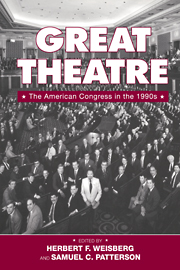Book contents
- Frontmatter
- Contents
- Figures and Tables
- Preface
- Contributors
- Introduction
- Congress and Its Audience
- Congress at Play
- 5 Directing 535 Leading Men and Leading Ladies: Party Leadership in the Modern Congress
- 6 Little Theatre: Committees in Congress
- 7 The Unfolding Drama: Party and Ideology in the 104th House
- Congress and Other Actors
- Conclusion
- References
- Index
6 - Little Theatre: Committees in Congress
Published online by Cambridge University Press: 20 January 2010
- Frontmatter
- Contents
- Figures and Tables
- Preface
- Contributors
- Introduction
- Congress and Its Audience
- Congress at Play
- 5 Directing 535 Leading Men and Leading Ladies: Party Leadership in the Modern Congress
- 6 Little Theatre: Committees in Congress
- 7 The Unfolding Drama: Party and Ideology in the 104th House
- Congress and Other Actors
- Conclusion
- References
- Index
Summary
Committees are “the little legislatures” of Congress (Goodwin 1970), for in these small arenas much of the law-making work happens, and committee deliberation sets the stage for legislating on the House or Senate floors. Yet just as the dramas on a theatrical stage are more illusory than real, the same is true when Congress appears to institute radical reforms in committee structures. Congressional committees are marked much more by stability than by change – recent Republican reforms notwithstanding.
In 1890 a cartoon appeared in the Judge, a national political magazine that survived into the early 1900s. The cartoon shows congressmen bringing “goodies” back to their districts and cutting deals among themselves to support each others' bills. The date on the cartoon could just as well have been 1998. Despite all that has changed – the dramatic growth of the federal government, the growth of Capitol Hill staff, the explosion in the number of Washington lobbyists, the modernization of media outlets, the gradually developing presence of women and racial minorities, and so on – despite all this, Congress of the 1890s seems entirely familiar. So, too, the committees of the early 1880s, which preoccupied and frustrated Woodrow Wilson as he wrote Congressional Government ([1885] 1973). If we could put today's committee entrepreneurs in a time machine bound for the 1880s, they could navigate the policy process safely and with alacrity.
As the curtain rose on the House of Representatives in early 1995, Speaker Newt Gingrich and a legion of Republican freshmen promised sweeping changes in the committee system. It was not the first time political reformers had railed against committee structures.
- Type
- Chapter
- Information
- Great TheatreThe American Congress in the 1990s, pp. 135 - 151Publisher: Cambridge University PressPrint publication year: 1998
- 2
- Cited by



